In 1922, self-exiled English novelist D.H. Lawrence arrived on Australian shores with his German wife Frieda. Travelling by steamboat from Italy to New Mexico via Sri Lanka, the pair disembarked in Sydney to spend a bit of time rediscovering their land legs. Lawrence was already a well-known writer by this point, with works such as Sons and Lovers and The Rainbow having been published in the decade before. However, this is to say little of his and Frieda’s financial situation.
Passing through Sydney’s famed headlands, the pair held in their possession a modest sum of 50 pounds, and after handing over four of those pounds for two nights’ accommodation in the harbour city, it became evident they’d be needing to find cheaper lodging if they were to spend any significant time in “the continent of the kangaroo”.
Boarding the 2pm train from Central Station and heading south, they arrived in the seaside township of Thirroul (now a northern suburb of Wollongong) and took up residence at “Wyewurk”, a Californian-style bungalow overlooking McCauley’s Beach previously leased by a family of 11 children. It was here, writing at the breakneck pace of some 3,000 words a day, that the child-free Lawrence penned his eighth novel, Kangaroo, in a mere six weeks.

I’m ambivalent about Kangaroo. It contains passages as technically and poetically brilliant as any to have been jotted down in English prose before or since, its psychological insights are convincing and artfully understated, while its representation of the Australian landscape remains as evocative today as it was at the time of publication when it helped free a cohort of Australian writers from the anxiety of European influence under which they’d been toiling.
As far as storytelling goes though, Kangaroo, with its clandestine right-wing army forever marking time and making plans, does less to excite my imagination. If I’m being completely honest, for all its virtuosity it probably would have ended up in the great pile of perennially bookmarked classics I was determined to enjoy but never quite got around to finishing were it not for the special place it holds in the oeuvre, and heart, of legendary Australian artist Garry Shead.
Portrait of an artist
Shead first encountered Lawrence through a volume of the author’s letters while working on a documentary in the Sepik Highlands of Papua New Guinea. The year was 1968 and Lawrence had been dead for almost four decades. It made little difference to the impressionable young Shead. The connection transcended both time and space.
In Lawrence’s letters, Shead felt he’d discovered a kindred spirit, a portrait of the artist he took himself to be – however under-realised that vision might still have been at this early stage of his career. As art critic Sasha Grishin, who has spent significant time interviewing Shead and analysing his work and journals, explains,
[Shead] has always had a special relationship with Lawrence…There is also a strong sense of fidelity – a spiritual bonding. Lawrence is one of the few subjects that Shead will not joke about. Interviews turn sour whenever anyone is critical of Lawrence.
Returning from PNG to Australia, Shead set himself to reading as much of Lawrence’s work as he could get his hands on. Novels, poems, letters, psychoanalytical treatises – wherever the writer had trained his attention, Shead was there to reciprocate it. And when he ran out of printed artefacts, he boarded the same southbound train Lawrence had boarded half a century earlier and alighted at Thirroul – a pilgrimage that proved nothing short of life-changing.
For it was here, with his tattered copy of Kangaroo serving as a sort of mystical travel guide, that Shead began mapping out the series of paintings that would establish his reputation as a major national and international artist, a series Grishin likens to Sidney Nolan’s Ned Kelly series and Arthur Boyd’s Bride series in its conception and execution of a “new Australian myth”.
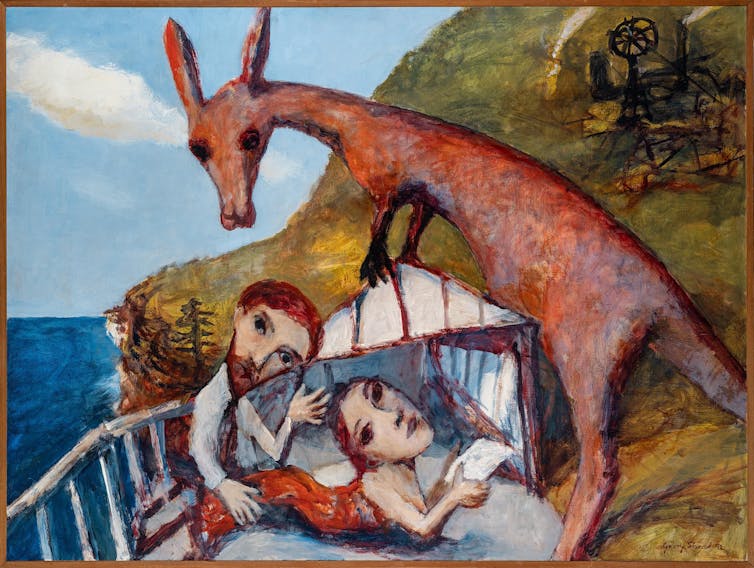
It’s difficult to put a figure on exactly how many paintings belong in Shead’s so-called D.H. Lawrence series. Does one include the prototypical D.H. Lawrence in Thirroul painting he completed in 1972 after that first trip south? How about the diptych, Portrait of D.H. Lawrence, which he painted the following year with his friend Brett Whiteley, the two of them renting the house next door to Wyewurk where they were sure they could “feel the presence of Lawrence hovering around the place”?
It goes without saying that one must include the 50 individual oil paintings made between 1991 and 1993, when Shead was at the height of his D.H. Lawrence fever, painting and “seeing everything clearly and all at once – whole and true, with the mind and emotions perfectly balanced, like a self-contained natural order”.
But what about the sporadic Lawrence-inspired works that would continue cropping up in the decade or two afterwards, when he’d done his best to move on from the novelist with equally well-received series based on Her Majesty Queen Elizabeth II’s 1954 visit to Australia (2000), or the life and death of fictitious poet Ern Malley (2003)? Try as he might, Shead has never quite been able to exorcise the ghost of Lawrence, which leapt off the page and into his psyche all those years ago.

Local connections
Mind you, I knew none of this when I wandered into Wollongong Art Gallery with half a dozen of my creative writing colleagues from the University of Wollongong back in 2017. We’d been invited to a private viewing of the gallery’s permanent collection in order that we might each choose a work to respond to as part of an upcoming exhibition titled, Jewels in the Crown.
Assembled in the foyer with notepads in hand and backpacks stowed safely in the cloakroom, we might have passed for a group of high-schoolers waiting for their art excursion to begin, had our median age not suggested something closer to the befuddled high school teachers who invariably tag along on such outings.
Eventually we were collected by the gallery’s public programs officer Vivian Vidulich – a woman whose impossibly radiant disposition could not possibly have shone in starker contrast to her trademark gothic attire and makeup. Down the corridor and into the subterranean temperature-controlled storage rooms she led us.
A week or so earlier, we’d been sent a catalogue of works to give us a rough idea of what was available, and I was keen to get a look at Thirroul artist Paul Ryan’s painting One Last Blackbird, which had been part of a controversial exhibition in 2010 resulting in protests and the temporary closure of the gallery. It was on my way to viewing this work, though, that the ghost of a still-living Shead didn’t so much leap off the page and into my psyche as grab me by the throat and drag me through the timber frame it was prematurely haunting.
The painting was titled Death of Kangaroo, and the best way I can think to describe its effect on me, is to say that I felt “separated” by it. Physically stepping away to get a better view, I could simultaneously feel my consciousness being sucked toward or into its dusky-skied funeral scene, at the centre of which lies the bloated, crucified body of the totemic Kangaroo with his head haloed in a divine, Christ-like light.
At that point, the decision seemed less mine to make as to accept: this would be my painting, the work I would write about. I even knew what I would write: a short story about the kangaroo I’d been instructed to kill while working as a farmhand during my first year out of school – a horrifyingly formative experience to be sure.
I’d describe the farm owner’s Texan-style moustache, the way he’d chastised me for deigning to waste a second bullet on the animal I’d only managed to maim with my first shot, the hoe in the back of the ute with which I was expected to finish the job, the pocketknife I was handed for the purpose of procuring dog meat afterwards, and finally the hands that would have made Lady Macbeth’s look clean by comparison. I’d cleanse myself of this decades-old atrocity with a public confession.
A half-finished version of this story exists and is still taking up storage space on my hard drive. But it isn’t the work I ended up reading at the Jewels in the Crown exhibition. At some point along the way, this unpleasant memory of mine became entangled with somebody else’s unpleasant memory and the work moved in an unexpectedly lyrical direction.
“I had an experience when I was a kid when I used to go to the country with my dad,” begins Shead in a documentary I came across while researching the painting.
I did all the things that men do, you know, go out and shoot things. On one occasion there was a mob of kangaroos and the men told me to stay in this one spot. I was by myself, I was about 15 or 16 with my .22 and this old man kangaroo came by himself loping into the area where I was, and I did what I was supposed to do and took aim and shot him. But I was shattered really. This beautiful creature just dying there. And that was another very important thing that was in the background of this painting. I realised I was trying to repent for what I’d done and that’s why I put the halo.
I don’t want to make too much of this biographical coincidence. This is Australia after all and, having grown up in the country as I did, I know such experiences are not rare. Of more interest and value to me was the glimpse into Shead’s thinking and, in turn, artistic process.

In Lawrence’s novel, he’d discovered a lens through which to examine this key event from his own life and, in Lawrence, a figure onto whom he could overlay his artistic ambitions. The resulting series would be a conglomerate of personal history, biographical research, narrative interpretation and lyrical mysticism, all metaphorised through the world of Lawrence’s mysterious Kangaroo. Through Lawrence, Shead would discover his voice as an artist, just as through Shead, I would set out to discover my own as a poet.
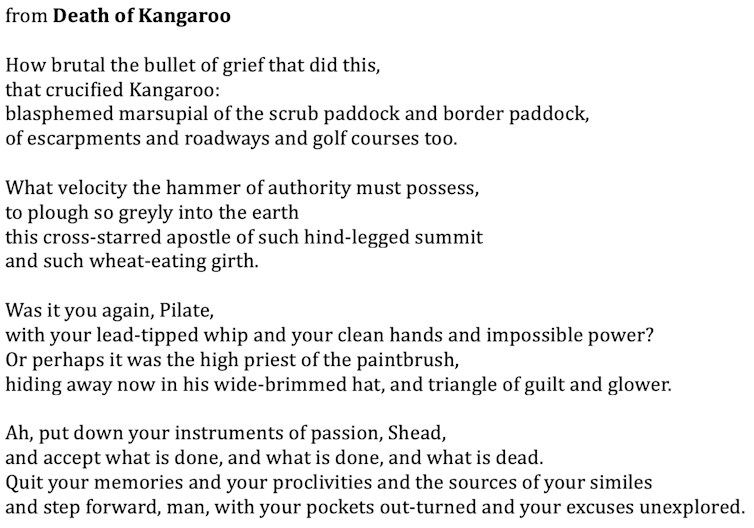
Fanning the flame of influence
In his seminal books, The Anxiety of Influence and A Map of Misreading, literary theorist Harold Bloom argues that poets – or artists, to apply his theory more broadly – toil under the legacy of those stronger artists to have come before.
According to Bloom, it’s the fear of failing to meet the standard set by these forebears that inspires, and then for the most part destroys, each new generation of artists. Under this paradigm, which Bloom models on the competitive father–son relationship encountered in Freudian psychoanalysis, only the strongest manage to wriggle free of the paternal influence and rise to the canonical level of precursor artist themselves – or, as Bloom emphatically puts it: “Poetic strength comes only from a triumphant wrestling with the greatest of the dead.”
I seem to remember coming across a Charles Bukowski story in which the author’s alter-ego goes toe-to-toe with Ernest Hemingway in a boxing ring (nothing subtle about that!), and certainly much has been made of Johannes Brahms’s struggle to compose in the wake of Ludwig van Beethoven’s imposing legacy. Both Bukowski and Brahms wound up producing exceptional art in their lifetimes, so who knows – perhaps Bloom’s theory holds true for some variety of artist.
For me, though, the idea of being locked in neurotic competition with those artists I look up to, those who have nurtured and shaped my sensibilities through their own struggles and offerings, is an affront to the spirit of gratitude that characterises my creative efforts. I don’t feel in competition with these figures, I feel indebted to them.
Or, to shine a light on a different vector of the Oedipal triangle, it isn’t paternalistic fear or anxiety they inspire in me so much as a quasi-maternalistic desire. As Freud’s preeminent successor Jacques Lacan would have it, we learn not only what to desire from our mothers, but how to desire it – a discovery Lacan highlights when he employs the deliberately ambiguous phrase le désir de la mère which can mean both “the desire for the mother” and “the desire of the mother”.
The American novelist Henry Miller – another of Lawrence’s fervent admirers – seasons this variety of desire with artistic flavour when he writes:
The only way to do justice to a man like Lawrence who gave so much, is to give another creation. Not explain him, but prove […] that one has caught the flame he tried to pass on.
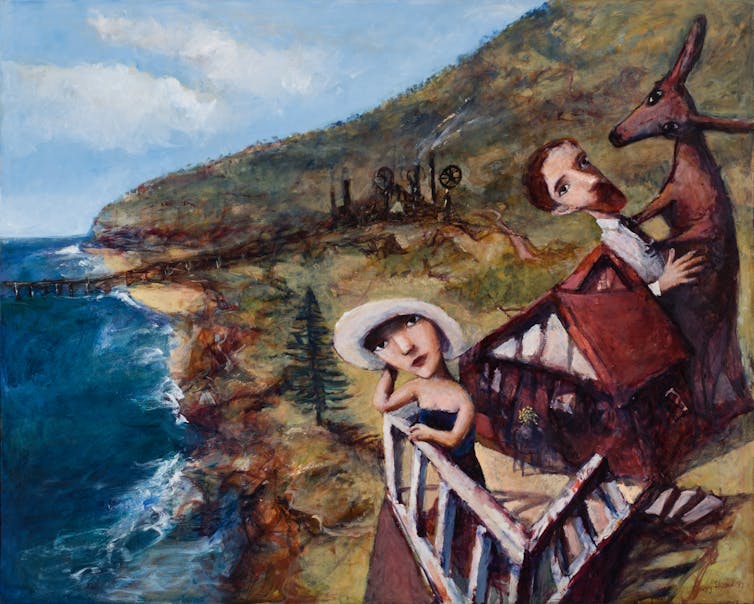
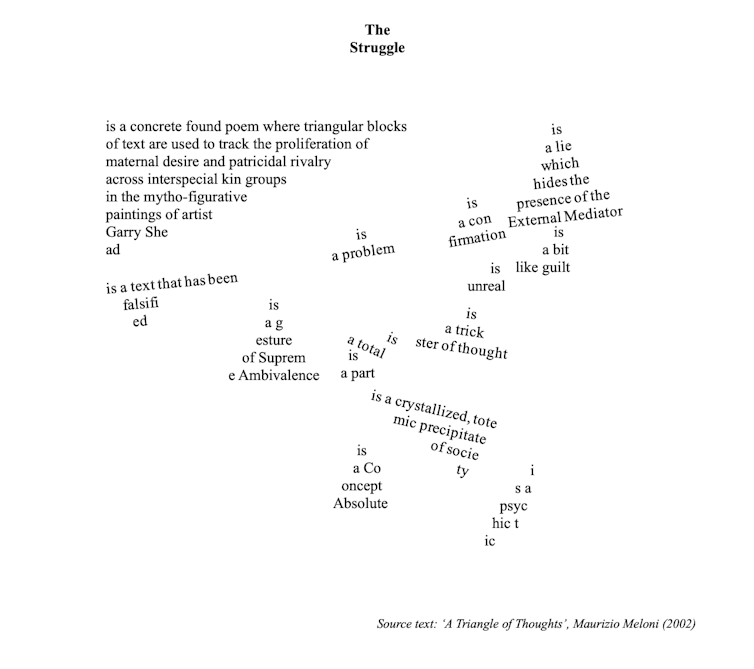
The poem I ended up writing for the event at Wollongong Art Gallery was the spark from which a much larger fire has grown. For several years now, I’ve been busy scrawling away with a monograph of Shead’s D.H. Lawrence series lying open on the table beside me, creating a series of some 50 poems that take their inspiration and titles from the works made by Shead between 1991 and 1993.
In some Baudelairean sense, each poem aspires toward a transposition of art from the visual register to the linguistic, which speaks to the project’s formal dimensions and the slew of technical problems I’ve had to overcome in turning them into literary artefacts. But transposition is far from the motivating factor for this project, just as I feel confident in proclaiming it far from the motivating factor for Shead, whose response to Lawrence has been described as “intuitive” and “personal” rather than merely “illustrative”.
Really, the key motivating forces here are gratitude and reciprocity – the impulse to return the favour by “paying it forward”, as it were. To create something in the likeness and spirit of its source so the flame might continue burning for another few years at least.
On this note, it doesn’t surprise me to hear interviews turn sour when journalists make light of Lawrence in Shead’s company. Shead never met Lawrence – they work, for the most part, in completely different media, and yet it would be difficult to name somebody who’s had a bigger impact on his artistic life than Lawrence. To poke fun at Lawrence in Shead’s presence would be to throw water over the flame, to trivialise the sacrosanct nature of the relationship from which Shead clearly derives so much of his artistic strength.
By this, I don’t mean his unique strengths as an artist (“a figurative painter with a flair for allegory and symbolism”, and so on), but rather the strength to make art in the first place. Lawrence is to Shead as Virgil was to Dante, a mythologised figure he has entrusted – and in many ways constructed – to guide him downward into the spiralling underworld of his creative unconscious and out the other side again. Where my own recent poetic adventures are concerned, that guiding light is Garry Shead.
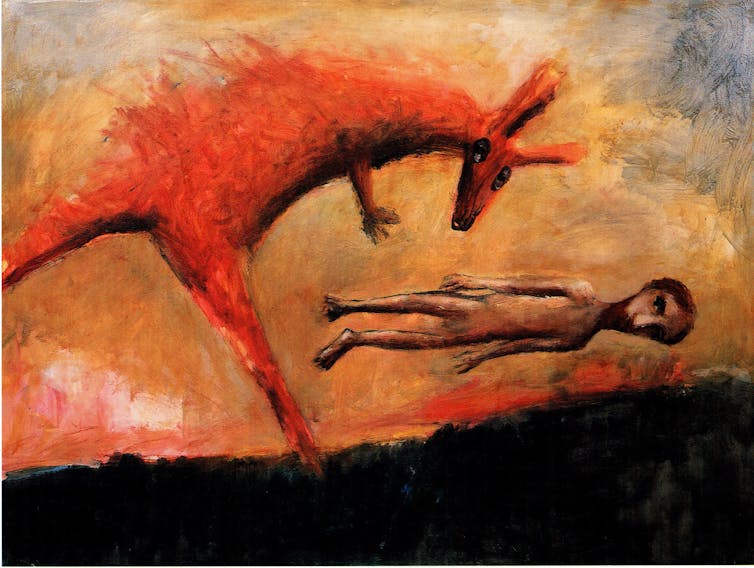
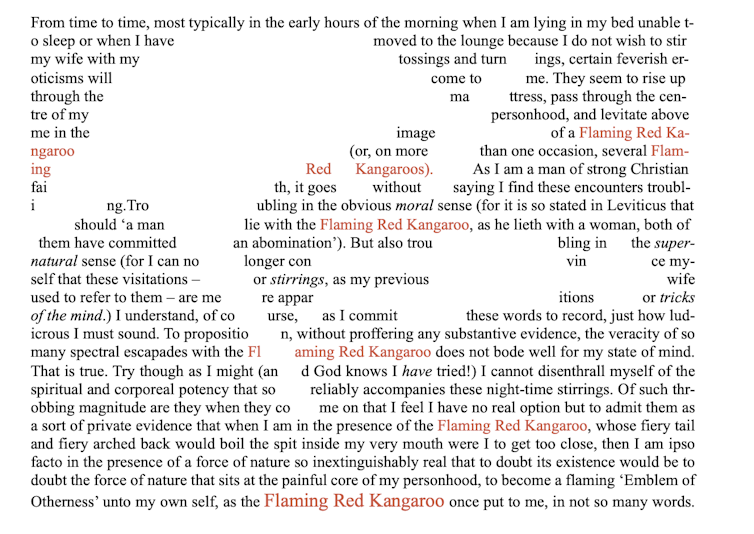
Heroic encounters
They say never meet your heroes: they can’t possibly live up to your expectations and you’ll inevitably wind up disappointed. For Shead, this was obviously never a concern – Lawrence died of tuberculosis 12 years before he was born. In my case though, history has provided no such safeguards. At 82 years of age, Shead is not only still alive, but still producing new work.
I know because I had the opportunity to visit him in his studio last year after he contacted the University of Wollongong, offering to donate a complete set of etchings and collagraphs from his D.H. Lawrence series to celebrate the 100-year anniversary of Kangaroo’s publication. He’d become aware of my poems a few years earlier when I emailed him, requesting copyright permission to reproduce a painting for publication alongside its corresponding poem.
It was an interaction I’d been fretting over since I began the project – my worry being that he wouldn’t merely dislike my rendering, but that he’d be incensed to discover the liberty I’d taken in adapting his work in the first place and demand I put a stop to it. Fortunately, this isn’t how it played out. To cut a long story short, he enjoyed the original poem and took an interest in reading more. And, as I was shameless enough to oblige, I now found myself in the unlikely position of meeting him in person at one of the university cafés to discuss a possible collaboration.
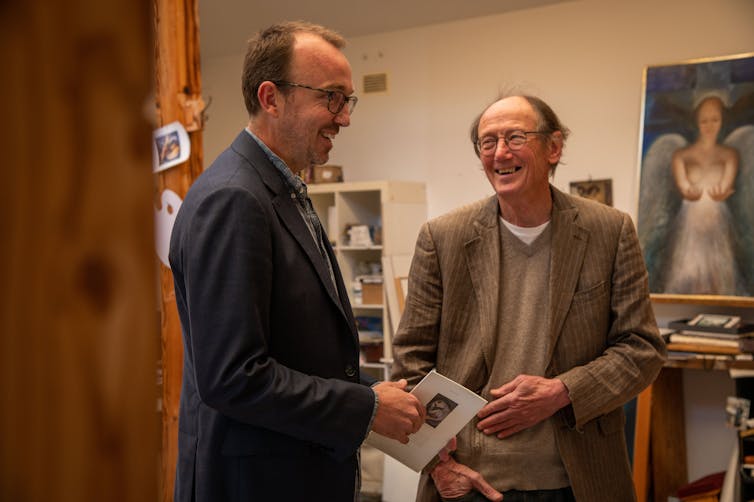
The outcome was a poetry-art exhibition, titled Kangaroo Unbound, co-curated by artist and academic Teo Treloar. Etchings, collagraphs and paintings on loan from Wollongong Art Gallery as well as Shead’s private collection were hung in the university gallery alongside the poems I’d written in response to such works. Glass-top vitrines were filled with etching plates, process prints, early drafts of the poems, and various other paraphernalia (including an early edition copy of Kangaroo annotated by the barber who’d cut Lawrence’s hair during his time in Thirroul!).
There was a public lecture by local historian and Lawrence scholar Joseph Davis and an address by Shead himself, who spoke (not surprisingly) of Lawrence, author of that “eternally contemporary … book of observations, meditations and prophesies”, Kangaroo. While it had been one thing to trade compliments with this artistic hero of mine via email, I don’t mind admitting it was quite another to saunter around the gallery with him on opening night. A definite highlight of my admittedly modest writing career.
Spiritual mentors
After shaking Shead’s hand goodnight and wishing him a safe trip home, I accompanied a small group of friends and colleagues to a nearby hotel for dinner and drinks. One of these colleagues had some years earlier presented me with a small return-to-work gift, a book of essays she’d found insightful, called Light the Dark: Writers on Creativity, Inspiration, and the Artistic Process.
No doubt it was a combination of being in her company while thinking through many of the ideas presented here in this essay that I remembered a passage I’d underlined on my first read. It belonged to a short essay called Strangers on a Train, by the celebrated novelist Yuyin Li.
I pulled it down off my shelf as soon as I got home. “I like to think you write a book to talk to another book. Or write a story to talk to another story,” Li offers, on her way to explaining the role that influence has played in her work.
I remembered it had resonated strongly with me at the time of reading as I’d just published my own debut collection of stories and could’ve opened any random page of this book and told you the exact work I was attempting to “talk to” when writing.
Typically, the impetus amounted to noticing something novel or impressive in another writer’s work and wondering whether I had the chops to pull off the same manoeuvre in my own work. Bloom speaks of creative corrections, where one seeks to improve on the mistakes or shortcomings of one’s forebears, but this is more a process of identifying the strengths of one’s forebears and building upon them – standing on the shoulders of giants, as it were.
While the Shead poems started out in a similar manner, something happened along the way that led to me straining to see behind the canvas. My interest in the paintings, and their subsequent influence, became more personal, just as I believe it did for Shead, whose figurations, while ostensibly based on Lawrence and Frieda, have been labelled “beguilingly autobiographical” by arts columnist Bronwyn Watson, who notes that “Frieda is based on Shead’s wife while Lawrence is based on the artist” himself.
In his Lectures on Russian Literature, Vladimir Nabokov advises the “good [and] admirable reader” to identify himself “not with the boy or girl in the book, but with the mind that conceived and composed the book”. Making my way through this Shead-inspired writing project, this was the state in which I so often found myself – trying as best I could to identify with the mind that composed the iconic series of paintings.
And while I’ve never asked him directly, and am willing to stand corrected, I would wager a similar impulse lies at the heart of Shead’s interpretation of Lawrence’s novel. Having spent much time with these works now, the series strikes me as being less concerned with the novel than with the sensibility that shaped it, that is with “the spiritual mentor, whose fate [Shead sees as being] somehow mysteriously and inextricably bound up with his own”.
The paintings seem to me Shead’s best attempt at entering into direct communion with the man who sojourned in Australia all those years ago, becoming one with Lawrence’s spirit as it were, in an effort to keep alight the flame he brought with him on that long voyage across the Indian Ocean.
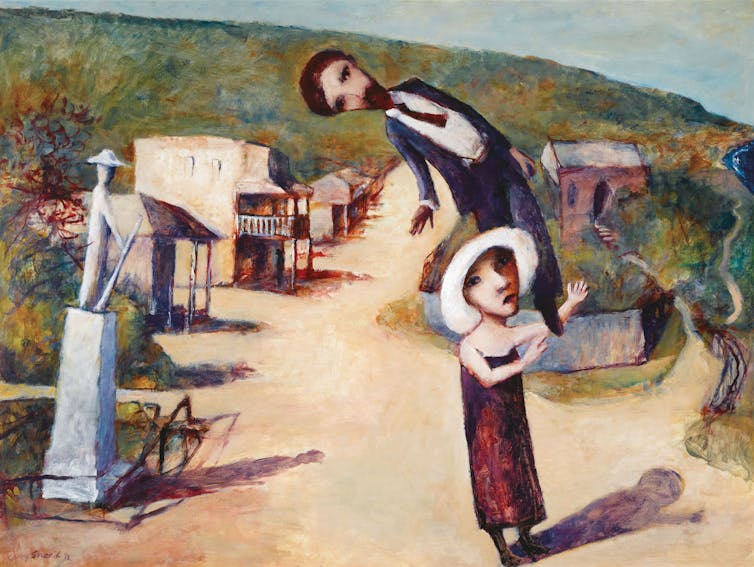
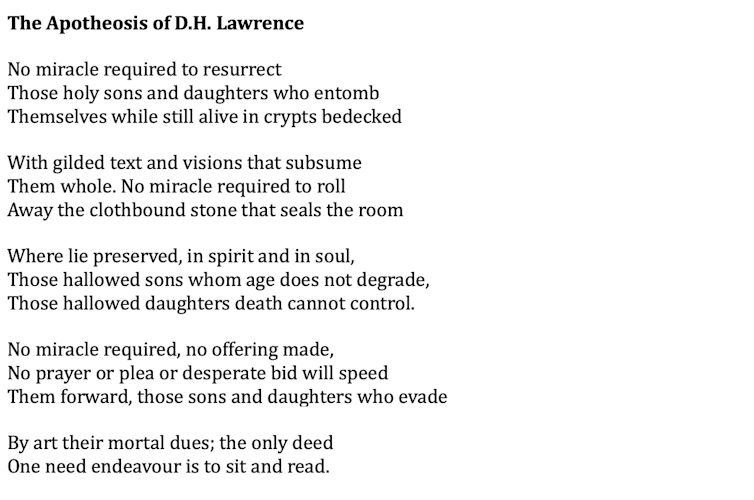
From the embers
During the final days of the Kangaroo Unbound exhibition, one of the visual arts lecturers brought her class of first-years to the gallery for a tour. As I wandered around the space talking to small clusters of students about Shead’s artworks and their connection to Lawrence and the Illawarra region more generally, I couldn’t help but notice the young woman sitting cross-legged on the polished concrete floor in front of Death of Kangaroo.
She was by herself and seemed happy enough to be left alone, and so I didn’t interfere. To my delight, though, she stopped on her way out to thank me for the exhibition. She told me she’d never heard of Shead until then, but upon entering the gallery had immediately been drawn to that same painting I’d found myself drawn to all those years earlier – the one on loan from Wollongong Art Gallery.
Moving in closer, she’d taken the time to read the poem hanging alongside the work too, and had found something appealing in its closing lines:
Lift Up Your Hearts And Pray Pardon To The Land Which Is God,
for the blood of the bushfire is new and everlasting
and only It may rightfully forget or undo
– a morte iniquitatis Macropus –
this iniquitous death of Kangaroo.
“Here,” she said, passing me the spiral-bound notebook she was clasping in her hand.
With impressive fidelity, she’d sketched the crucified body of Kangaroo onto the cotton-rag paper with a graphite pencil, titling it, “The Iniquitous Death of Kangaroo”.
Standing under the gallery’s museum-standard lighting, I held the work in front of me at arm’s length and couldn’t help but smile at what I saw. The halo around Kangaroo’s Christ-like head was glowing with a burning intensity that I recognised immediately. Somebody else had encountered the flame.

